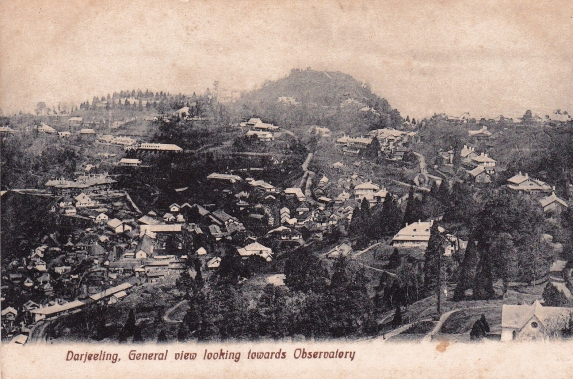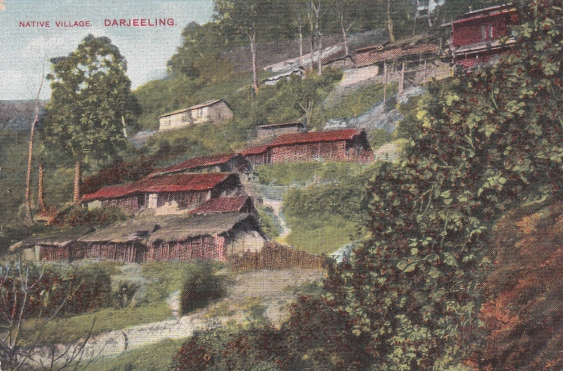Digging into my (admittedly rather small) old postcard collection, I came across a few picturing Darjeeling.

On this first one, other than the title, there is no information on the card. It is unused (as are the other two here), so I do not even have a postmark to help me guess what date the picture was taken. I would guess, however, that although the postcard was probably printed in the 1930’s, the photo could be ten or twenty years older than that. It looks as though the road on the right is The Mall, and the one running from left to right a little way below the skyline could be Hill Cart Road. Looking through a magnifying glass, it is possible to see that there are plenty of pedestrians, but I cannot make out a single vehicle. The photo would have been taken from a high spot on Dr Zakir Hussein Rd, near where the TV tower now stands.

The second one is simply labelled ‘Native Village, Darjeeling’, and is the representation of a hand-tinted black and white photo. ‘Darjeeling’ is much more than the town, of course, and covers a large area all around it. Other than that, I could not hazzard more than a guess where this village lies. Searching through a few internet sites, however, I found another copy of this with a date of 1910.

Finally, ‘The Railway Loop above Tindharia, Darjeeling’. Also hand coloured, this particular picture appears to be a copy of a photograph taken in 1880 by Bourne and Shepherd. Also known as ‘Agony Point’, this was built to enable trains to tackle the steep gradients by spiralling around instead of going straight up or down. It is renowned for being an incredibly tight loop.
Perhaps this is also a good place to slip in a link to my previous blog post:
My First Long Trip to India (5) in which I wrote about my impressions of Colonial era India when I visited Darjeeling for the first time.

These are beautiful! That rail track does look a bit tight, though. More like something you might find at a theme park!
LikeLiked by 1 person
It’s quite a bend! The train is known colloquially as the Toy Train’, because it’s a narrower gauge than usual, but it’s still big enough and the curves are mightily impressive!
LikeLiked by 1 person
You are certainly a man who appreciates impressive curves, Mick 😉
LikeLiked by 2 people
Fnarr fnarr!
LikeLiked by 2 people
Enjoyed this post running through these pictures, Mick. It is quite likely that the first picture is from 19th century when the photographers appeared in India. Just a guess!
LikeLiked by 1 person
You could well be right, Arv. The complete lack of vehicles made me wonder if that might be the case. If I had more time, I would try to identify a few of the individual buildings and find out when they were built.
You knew, of course, that I put this post up for you, Arv.
LikeLiked by 1 person
That’s so kind of you, Mick. I did ask you for some pictures, I remember.
LikeLiked by 1 person
You’re most welcome, Arv. Happy to oblige!
LikeLiked by 1 person
Thank You Mick for extending this privilege. It’s always great to have a look at your “prized possessions” 🙂
LikeLiked by 1 person
you posted something similar Arv with the railway and the ! “switchback”
I remember commenting on the 90 degree turn..
LikeLiked by 1 person
You are right Jackie. It’s a same picture of a loop on Darjeeling train route but a different version. 🙂
LikeLike
What beautiful cards, Mick. It’s so interesting how old cards like that evoke an emotional response, while modern-day glossy photos don’t seem to. Thanks for sharing.
LikeLiked by 1 person
You’re welcome, Donna. I think it’s the distance in time that does it. Even photos from 20 or 30 years ago are interesting if the subjects have altered in that time.
LikeLike
I love old postcards. I have a bunch from Indonesia, where my mom is from. These remind me of those. They’re beautiful. Thanks for sharing, Mike. 🙂
LikeLiked by 1 person
You’re welcome, Diana. I’d love to find some more – I don’t really collect them, but occasionally just come across something of interest.
LikeLiked by 1 person
I love old postcards and try to buy them ( along with old family photographs) whenever I am in a Colonial Hotspot, or should that be ex Colonial Hotspot. I really enjoyed looking at the postcards and the history behind them. Thank you very much. I had already read your previous linked Blog but it was just as interesting to re-read especially looking at the photos -almost like ” The Shires, eh, what??”
LikeLiked by 1 person
Thanks, Jackie. I will put a few more up at some point – apart from anything else, it’s a good excuse for me to do a little more research.
LikeLike
You could write a great book regarding the Old Colonial time with a few of those postcards as images….
LikeLiked by 1 person
I think it would be a nightmare trying to track down any copyrights that existed!
LikeLiked by 1 person
I wonder what changes have been wrought since the pictures were taken Mick. In fact, since your visit was some time ago I wonder whether you’d recognise anywhere.
Hugs
LikeLiked by 1 person
I was last there in early 2015, and although Darjeeling has certainly become more crowded, with more ‘in-filling’ of houses, it is still very recognisable from the older pictures. the main difference, as in many places, is the massive amount of traffic, now.
Hugs back!
LikeLiked by 1 person
These postcards are a treasure to behold! The ‘Native Village’ could be Nepal today.
LikeLiked by 1 person
Yes, a distinct similarity!
LikeLike
Postcards are always mesmerising, bringing back lot of memories. But am sad nowadays we don’t buy all these. This trend is reduced. Your postcards are so beautiful and I liked them a lot. Am wondering how you looked into the first one and spotted the places from them. It shows how much you have enjoyed Darjeeling Mick.
Meena
LikeLiked by 1 person
It’s not too hard to orientate the picture, knowing that Observatory Hill is in the background. And a magnifying glass really helped!
No, I don’t think we buy so many, nowadays. We all take loads of photos, and think that will do. But postcards are great for those places you never quite get to, and when they are historic, that’s even better. there’s something special about realising that you’re standing in the same spot that the picture was taken 50 or 100 years ago. More about this later, possibly…
LikeLiked by 1 person
Yeah true. Nowadays cameras in hand makes life easier.
LikeLiked by 1 person
awesome! d postcards give such old world charm feeling
LikeLiked by 1 person
They do, yes. And exciting when you can still recognise the places!
LikeLiked by 1 person